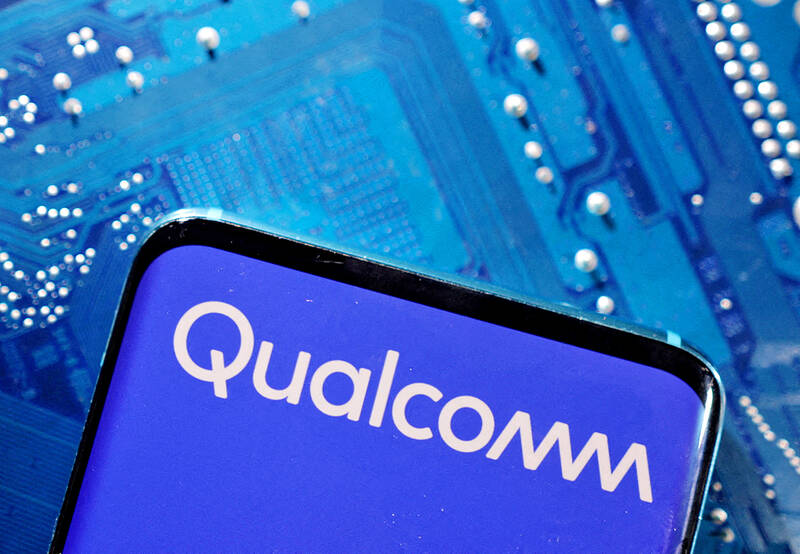Qualcomm Inc and Arm Holdings PLC, two chip companies heavily dependent on the smartphone market, on Wednesday delivered earnings reports that showed an industry making a wobbly comeback.
Both companies pointed to a resurgence in demand for high-end model devices, but stopped short of signaling that the broader industry was on solid ground.
The return of consumer spending on expensive handsets, particularly in China, helped both companies’ revenue and profit top analysts’ estimates last quarter.

Photo: Reuters
Expansion into new areas also shored up results. Qualcomm and Arm are pushing deeper into computing, bringing a boost from artificial intelligence spending, while Qualcomm has made a successful foray into automotive chips.
The two companies — longtime partners that have increasingly become adversaries — are seen as bellwethers for the smartphone industry. Qualcomm is the biggest seller of the processors that power the devices, and Arm developed much of the underlying technology used by the industry.
For the coming year, Qualcomm is predicting that overall phone units would grow roughly 5 percent or less — a sign it is not anticipating a wide recovery. Many consumers are not upgrading their devices as often, a problem that has plagued much of the industry.
Arm projected revenue of US$920 million to US$970 million for the December quarter. The midpoint of that range would fall short of the US$950.9 million that analysts had estimated.
Qualcomm expects sales of US$10.5 billion to US$11.3 billion during the period. Analysts estimated US$10.5 billion on average, according to data compiled by Bloomberg. Profit, minus certain items, would be as much as US$3.05 a share, beating Wall Street projections.
The automotive market was a bright spot for Qualcomm, despite a slump in that category that has hurt other chipmakers. Revenue was up 55 percent in fiscal this year. The San Diego-based company said that it has been winning new business, helping it outshine peers.
“I think you should look at our revenue in auto less sensitive to what happens in the market, much more related to new models that are being launched,” Qualcomm chief executive officer Cristiano Amon said on a conference call with analysts. “It’s reflecting a shifting share.”
In the September quarter, Qualcomm’s profit was US$2.69 a share, excluding some items. Revenue rose 19 percent to US$10.2 billion. Analysts had estimated earnings of US$2.56 a share and sales of US$9.91 billion.
At Arm, revenue during the period rose about 5 percent to US$844 million. That compares with the US$810.9 million analysts had projected. Earnings were US$0.30 a share, excluding some items. Analysts had estimated US$0.26 on average, according to data compiled by Bloomberg.

SEEKING CLARITY: Washington should not adopt measures that create uncertainties for ‘existing semiconductor investments,’ TSMC said referring to its US$165 billion in the US Taiwan Semiconductor Manufacturing Co (TSMC, 台積電) told the US that any future tariffs on Taiwanese semiconductors could reduce demand for chips and derail its pledge to increase its investment in Arizona. “New import restrictions could jeopardize current US leadership in the competitive technology industry and create uncertainties for many committed semiconductor capital projects in the US, including TSMC Arizona’s significant investment plan in Phoenix,” the chipmaker wrote in a letter to the US Department of Commerce. TSMC issued the warning in response to a solicitation for comments by the department on a possible tariff on semiconductor imports by US President Donald Trump’s

The government has launched a three-pronged strategy to attract local and international talent, aiming to position Taiwan as a new global hub following Nvidia Corp’s announcement that it has chosen Taipei as the site of its Taiwan headquarters. Nvidia cofounder and CEO Jensen Huang (黃仁勳) on Monday last week announced during his keynote speech at the Computex trade show in Taipei that the Nvidia Constellation, the company’s planned Taiwan headquarters, would be located in the Beitou-Shilin Technology Park (北投士林科技園區) in Taipei. Huang’s decision to establish a base in Taiwan is “primarily due to Taiwan’s talent pool and its strength in the semiconductor

An earnings report from semiconductor giant and artificial intelligence (AI) bellwether Nvidia Corp takes center stage for Wall Street this week, as stocks hit a speed bump of worries over US federal deficits driving up Treasury yields. US equities pulled back last week after a torrid rally, as investors turned their attention to tax and spending legislation poised to swell the US government’s US$36 trillion in debt. Long-dated US Treasury yields rose amid the fiscal worries, with the 30-year yield topping 5 percent and hitting its highest level since late 2023. Stocks were dealt another blow on Friday when US President Donald

UNCERTAINTY: Investors remain worried that trade negotiations with Washington could go poorly, given Trump’s inconsistency on tariffs in his second term, experts said The consumer confidence index this month fell for a ninth consecutive month to its lowest level in 13 months, as global trade uncertainties and tariff risks cloud Taiwan’s economic outlook, a survey released yesterday by National Central University found. The biggest decline came from the timing for stock investments, which plunged 11.82 points to 26.82, underscoring bleak investor confidence, it said. “Although the TAIEX reclaimed the 21,000-point mark after the US and China agreed to bury the hatchet for 90 days, investors remain worried that the situation would turn sour later,” said Dachrahn Wu (吳大任), director of the university’s Research Center for